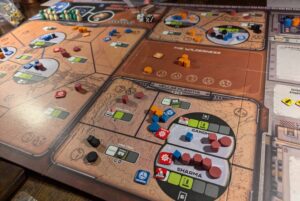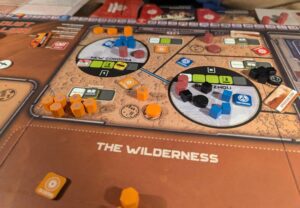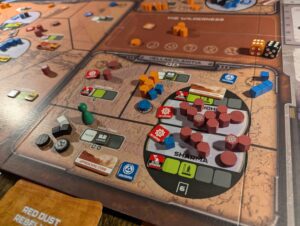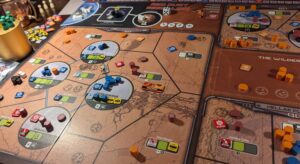Breaking from a successful tradition can be a risky proposition. With a set of games as popular and beloved in the wargaming community as GMT’s Counter Insurgency (COIN) series, where the details of a specific time and place are key factors in their designs, you jeopardize losing the essence of what makes it special by removing it from history altogether.
Red Dust Rebellion (Volume XII) takes place in a fictionalized future. 200 years after colonization, Mars is still a harsh place, albeit one that has been shined up and bears an eerie resemblance to the planet we currently live on. The Martian Government (MarsGov) and Earth-controlled Corporations (the two COIN factions of this game) work to build support from the local Martian population and maximize profits while keeping the rebel Red Dust Movement and fanatical Church of the Reclaimer in check. On its surface, this looks like the setup for every previous entry in the series, but where all of those preceding games are based on real-life struggles and events, Red Dust Rebellion isn’t bound by such historical elements and has the freedom to take liberties where others could not. But freedom is a tricky thing.

Familiar Faces
Most veteran COIN players will recognize around 70 percent of the rules governing Red Dust Rebellion, especially if they’ve played a few that include a complex and unique faction, such as Liberty or Death (Volume V) or Falling Sky (Volume VI), since the core gameplay elements of turn structure, resolving events, and conducting operations remains, for the most part, consistent with prior games. The Mars map itself is expertly designed and easy to make sense of, though some of the peripheral areas outside of the main planet, specifically the Aldrin Cycler, Flashpoint Track, and Earth Government Confidence Track, are unconventional additions that players will need to get acquainted with, but they are relatively straightforward and I never found them difficult to grasp once the game got underway. What really sets this volume apart from those preceding it is how the factions operate and work together (or against one another).
At first glance, you could look at the four factions and assume that they run similar to other COIN games, with the pairs of insurgent and counterinsurgent groups working semi-cooperatively to achieve their goals, yet having their own particular achievements to win the game outright. For the first few rounds, Red Dust Rebellion follows that formula. Not long into a playthrough, however, you’ll realize how much these factions contrast with the ones you’re accustomed to.
Fractured Factions
While MarsGov and the Corporations work together to raid the hearts, minds, and pockets of the population on Mars, the government back on Earth has a lot invested in Martian ventures. EarthGov — a non-player faction — brings experienced troops and impressive satellites to boost actions taken on Mars, but only one of the two counterinsurgent factions control these assets at any point and they can provide a massive strategic advantage to the controlling faction.
This tug-of-war for EarthGov control leads to handcuffing between two factions to a degree that I haven’t seen in other COIN entries. MarsGov, worried about support from the populace and attacks from insurgents, needs these extra forces to keep order, while the Corporations care little for what the people want, and merely desire the improved strength to protect their structural investments. Whichever faction controls how, when, and where the EarthGov assets are used becomes critical to both the shared and unique goals of each faction, and it can lead to some tense moments between allies.
The Red Dust Movement are native-born Martians who are tired of all of this Earth influence and are ready and willing to remove it and instill a true, independent planet: For the Martian People, By the Martian People. While they play the closest to previous games’ insurgent groups, the game adds some interesting Campaign Cards exclusive to the faction, which can only be played during certain events, and it adds a little variety, but they never felt too overpowered. Always concerned about dwindling resources, Red Dust utilizes the power of the people to reclaim Mars for themselves, while avoiding raids and attacks on their colonies. You know, classic rebellion stuff.
Then there’s the Church of the Reclaimer…

“They came in from the Wilderness…”
So far, each faction has acted like you might expect from a typical COIN game, aside from the odd rule tweak or enhancement here or there. The Church of the Reclaimer (CR) are a “post-humanist faith” uninterested in any type of human progress, regardless of political or economic goals, and are hoping to return Mars to its natural state: dust. They don’t play by the normal rules and, for most of the time, it feels like they are not even playing the same game.
My first clue that helming this nutty gang of religious fanatics was going to be different was when I couldn’t find the resource disc to place on the point-tracker like everyone else. Also, as I looked through the event deck, I noticed that the CR was last in eligibility order on every single card. “That hardly seems fair” I thought. Well, my friend, that is because the CR don’t acquire or use resources like any other player in this (or any other) COIN game. They have their very own deck of multipurpose asset cards, hidden from the other players, that they will use to take most of their actions. Want to jump the turn order on any event card? Sure, just turn in a card for each spot you want to move up. How about a permanent ability for the rest of the game? They’re in there. Want to unleash an event as powerful as those in the shared deck, except no other players can see it ahead of time to prepare for it? Surprise! Just like the faction itself, these cards are chaos incarnate. And it’s not just these cards that set the CR apart from the other factions.

Every time the shared event card is revealed, there’s a lightning symbol with a number on each, which moves the Flashpoint track up, and when that baby goes past 4, guess what? Dust storms! Each of the regions on Mars is now eligible, through a dice roll, to become enveloped in a raging storm. A number of troops or rebels will be removed immediately, with the region being made completely impassable until the next Flashpoint round, becoming a pain for everyone. Except, of course, those dust-loving lunatics in the CR. They can still move freely through all raging storms and if they have a base in those locations, they actually add a rebel piece to each one. They also remove an extra enemy piece of their choice from each raging storm region. Sometimes, it’s good to be different.
“A Creature Void of Form…”
It’s highly probable that your feelings on the Church of the Reclaimer faction will go a long way into whether or not you enjoy the game as a whole. In fact, I’m still on the fence about it. After several playthroughs as each faction, the ones where I played as the CR were, by far, the most fun. The other factions eventually become fearful of what the CR will be up to next because of the confusion that they can cause on every potential turn. This usually happens around the time the CR plays their first permanent ability or jumps you in the turn order for an event card you desperately need. Their movement ability allows them to pay zero resources to traverse the map, if they have a string of bases built, so they can strike a devastating blow at a moment’s notice from a faraway region and then disappear under the cover of dust just as quickly. It’s a blast.
That being said, I rarely actually won as the CR player, since those powerful asset cards can disappear quickly and it is difficult to obtain more before the next Dust Round — equivalent to the Propaganda Round in other COIN games — when victory conditions are checked and the map and resources are reset to some degree. Generally, the powerful and rich counterinsurgent forces eventually get sick of the chaos and team up to take downthe CR, leaving the door open for the Red Dust rebels to swoop in and take over.

With the inclusion of the extra rules, a fictional setting, and lawless factions, I expected to come away feeling like this might be a step too far from the substance of what I love about the COIN series. But it all really works. Even though some of the new elements seemed more like experiments than improvements, it always solidly felt like a COIN game, with all of the great strategy, asymmetry, and player interaction that I enjoy, albeit one with a lot more to absorb.
All of these advanced and redesigned parts work well in the old car, but you’ll need to check your owner’s manual often. Even after several playthroughs, I was still in the rulebook a good amount. This is easily one of the most complex games in the entire series — I would put it up there with Fire in the Lake (Volume V) and Pendragon (Volume VIII) — and I don’t think I’d suggest it for someone new to the system. It can be a lot just to learn the core rule set without the expanded facets in this entry. Kudos to the playtesters, as it must have taken quite an effort to make a game this heavy so well-balanced.
A Brave New Mars
Moving an established franchise based on documented and impactful insurgencies to a fictitious Mars setting was what most concerned and intrigued me when I first heard about the game while it was early in its development, roughly four years ago. Now that it’s been released and I’ve had a chance to really dive in, I can say, without hesitation, that it is no less exhaustive in its purview than any of the other volumes.

It’s notable that the game still contains a similar number of plotlines and actions playing out over the event cards as those drawn from historical conflicts, considering there were no real-life moments to research or draw from. Sure, there are some recognizable connections to a show like The Expanse and the Red Mars book trilogy, but good luck creating a fictional Mars-based universe these days without evoking these cultural touchstones, whether they were intentional or not. It’s still remarkable in its scope, and never felt like a copy-and-paste dystopian sci-fi tale, as many other games do. That this is designer Jarrod Carmichael’s first game makes this attention to detail even more impressive. That’s not to say Carmichael is new to the tabletop scene — he’s been making videos on his YouTube channel “3 Minute Board Games” for years — but not every content-creator-turned-game-designer comes out of the gate with such a strong title, and I’m very much looking forward to what he comes up with in the future.
It’s possible that COIN game purists may be turned off by some of the big swings taken in this latest volume, and the high barrier to entry in its rules may avert the casual game fan, but for those curious to see the series beyond its current limits and look to the possibilities of where it could go will be rewarded.













